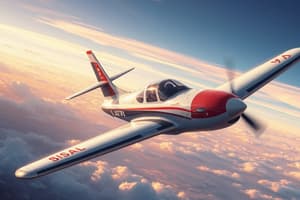Podcast
Questions and Answers
What is the average daily utilization of an aircraft in the industry?
What is the average daily utilization of an aircraft in the industry?
- 8-12 hours (correct)
- 15-18 hours
- 12-15 hours
- 6-8 hours
Fleet composition and aircraft type do not affect aircraft utilization.
Fleet composition and aircraft type do not affect aircraft utilization.
False (B)
What is the definition of aircraft utilization?
What is the definition of aircraft utilization?
Aircraft utilization refers to the amount of time an aircraft is in operation, generating revenue, and flying passengers or cargo.
On-time arrival rate is the percentage of flights arriving within _______________________ of their scheduled arrival time.
On-time arrival rate is the percentage of flights arriving within _______________________ of their scheduled arrival time.
Match the following factors with the correct aspect of airline operations:
Match the following factors with the correct aspect of airline operations:
What is the average on-time departure rate in the industry?
What is the average on-time departure rate in the industry?
Match the following metrics with their definitions in the context of aircraft utilization:
Match the following metrics with their definitions in the context of aircraft utilization:
Match the following factors with their effects on aircraft utilization:
Match the following factors with their effects on aircraft utilization:
Match the following benefits with the advantages of high aircraft utilization:
Match the following benefits with the advantages of high aircraft utilization:
Match the following challenges with the drawbacks of high aircraft utilization:
Match the following challenges with the drawbacks of high aircraft utilization:
Match the following factors with their effects on aircraft utilization:
Match the following factors with their effects on aircraft utilization:
Match the following benefits with the advantages of high aircraft utilization:
Match the following benefits with the advantages of high aircraft utilization:
Match the following challenges with the drawbacks of high aircraft utilization:
Match the following challenges with the drawbacks of high aircraft utilization:
Match the following factors with their effects on aircraft utilization:
Match the following factors with their effects on aircraft utilization:
Flashcards are hidden until you start studying
Study Notes
Aircraft Utilization
- Definition: Aircraft utilization refers to the amount of time an aircraft is in operation, generating revenue, and flying passengers or cargo.
- Key metrics:
- Block hours: The time an aircraft spends flying, from gate departure to gate arrival.
- Daily utilization: The average number of block hours an aircraft flies per day.
- Annual utilization: The total block hours an aircraft flies in a year.
- Industry benchmarks:
- Average daily utilization: 8-12 hours
- Average annual utilization: 2,500-3,500 hours
- Factors affecting utilization:
- Route network and scheduling
- Maintenance and repair schedules
- Weather and air traffic control conditions
- Fleet composition and aircraft type
On-time Performance
- Definition: On-time performance refers to the percentage of flights that arrive or depart within 15 minutes of their scheduled time.
- Key metrics:
- On-time arrival rate: The percentage of flights arriving within 15 minutes of scheduled arrival time.
- On-time departure rate: The percentage of flights departing within 15 minutes of scheduled departure time.
- Industry benchmarks:
- Average on-time arrival rate: 80-85%
- Average on-time departure rate: 85-90%
- Factors affecting on-time performance:
- Air traffic control and weather conditions
- Aircraft maintenance and technical issues
- Crew availability and scheduling
- Ground handling and baggage loading efficiency
Aircraft Utilization
- Aircraft utilization is the time an aircraft spends generating revenue, flying passengers or cargo, and is a key metric for airline operations.
- Block hours measure the time an aircraft spends flying, from gate departure to gate arrival.
- Daily utilization is the average number of block hours an aircraft flies per day.
- Average daily utilization in the industry is 8-12 hours.
- Annual utilization is the total block hours an aircraft flies in a year, with an industry average of 2,500-3,500 hours.
- Route network and scheduling, maintenance and repair schedules, weather and air traffic control conditions, and fleet composition and aircraft type all affect aircraft utilization.
On-time Performance
- On-time performance measures the percentage of flights arriving or departing within 15 minutes of their scheduled time.
- On-time arrival rate is the percentage of flights arriving within 15 minutes of scheduled arrival time.
- On-time departure rate is the percentage of flights departing within 15 minutes of scheduled departure time.
- Industry benchmarks for on-time performance are an average on-time arrival rate of 80-85% and an average on-time departure rate of 85-90%.
- Air traffic control and weather conditions, aircraft maintenance and technical issues, crew availability and scheduling, and ground handling and baggage loading efficiency all impact on-time performance.
Aircraft Utilization
- Aircraft utilization is the percentage of time an aircraft is in use, generating revenue, compared to the total time it is available.
Key Metrics
- Block hours are the total time an aircraft is in the air, from departure gate to arrival gate.
- Cycle time is the time taken to complete a round trip, including turnaround time at the gate.
- Utilization rate is calculated by dividing block hours by the total available hours in a day.
Factors Affecting Aircraft Utilization
- Tighter flight schedules can increase utilization, but may also lead to delays and cancellations.
- Efficient ground handling and quick turnaround times can increase utilization.
- Regular maintenance and minimizing downtime can maximize utilization.
- Optimal crew scheduling can reduce downtime and increase utilization.
- Airport congestion can lead to delays, reducing utilization.
Benefits of High Aircraft Utilization
- Increased revenue through more flights and passengers.
- Reduced costs per flight hour.
- Improved efficiency through optimized schedules and operations.
- Enhanced customer experience through more frequent flights and convenient schedules.
Challenges of High Aircraft Utilization
- Increased utilization can lead to faster wear and tear on aircraft, increasing maintenance costs.
- Higher utilization can lead to crew fatigue, compromising safety and performance.
- Higher utilization can increase the likelihood of delays and cancellations.
Industry Benchmarks
- Average aircraft utilization rate is 8-10 hours per day.
- Top-performing airlines can achieve 12-14 hours per day.
- Lowest-performing airlines have a rate of 4-6 hours per day.
Best Practices
- Regularly analyze and optimize flight schedules.
- Implement efficient ground handling and turnaround procedures.
- Invest in aircraft maintenance and minimize downtime.
- Optimize crew scheduling and rostering.
- Monitor and adjust aircraft utilization rates regularly.
Studying That Suits You
Use AI to generate personalized quizzes and flashcards to suit your learning preferences.




